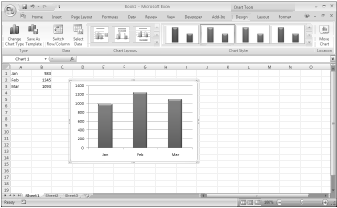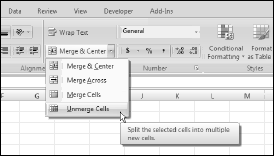Excel 2007 Ribbon
The most dramatic change in Office 2007 is the new user interface. Traditional menus and toolbars are gone, and they’ve been replaced with the Ribbon. Office 2007 is the first software in history to use this new interface, and it remains to be seen whether it will catch on and replace traditional menus and toolbars.
The commands available in the Ribbon vary, depending upon which tab is selected. The Ribbon is arranged into groups of related commands. Here’s a quick overview of Excel’s tabs.
- Home: You’ll probably spend most of your time with the Home tab selected. This tab contains the basic Clipboard commands, formatting commands, style commands, commands to insert and delete rows or columns, plus an assortment of worksheet editing commands.
- Insert: Select this tab when you need to insert something in a worksheet—a table, a diagram, a chart, a symbol, and so on.
- Page Layout: This tab contains commands that affect the overall appearance of your worksheet, including settings that deal with printing.
- Formulas: Use this tab to insert a formula, name a range, access the formula auditing tools, or control how Excel performs calculations.
- Data: Excel’s data-related commands are on this tab.
- Review: This tab contains tools to check spelling, translate words, add comments, or protect sheets.
- View: The View tab contains commands that control various aspects of how a sheet is viewed. Some commands on this tab are also available in the status bar.
- Developer: This tab isn’t visible by default. It contains commands that are useful for programmers. To display the Developer tab, choose Office > Excel Options and then select Popular. Place a check mark next to Show Developer Tab In The Ribbon.
- Add-Ins: This tab is visible only if you’ve loaded a workbook or add-in that customizes the menu or toolbars. Because menus and toolbars are no longer available in Excel 2007, these customizations appear in the Add-Ins tab.
The appearance of the commands on the ribbon varies, depending on the width of Excel window. When the window is too narrow to display everything, the commands adapt and may seem to be missing.
But the commands are still available. Figure below shows the Home tab of the Ribbon with all controls fully visible.
Figure below shows the Ribbon when Excel’s window is made more narrow.
Notice that some of the descriptive text is gone, but the icons remain. Figure below shows the extreme case when the window is made very narrow.
Some groups display a single icon. However, if you click the icon, all the group commands are available to you. In addition to the standard tabs, Excel 2007 also includes contextual tabs. Whenever an object (such as a chart, a table, or a SmartArt diagram) is selected, specific tools for working with that object are made available in the Ribbon.
Figure below shows the contextual tab that appears when a chart is selected.
In this case, it has three contextual tabs: Design, Layout, and Format. Notice that the contextual tabs contain a description (Chart Tools) in Excel’s title bar. When contextual tabs appear, you can, of course, continue to use all the other tabs.
Types of commands on the Ribbon
When you hover your mouse pointer over a Ribbon command, you’ll see a pop-up box that contains the command’s name, and a brief description. For the most part, the commands in the Ribbon work just as you would expect them to. You do encounter several different styles of commands on the Ribbon:
- Simple buttons: Click the button, and it does its thing. An example of a simple button is the Increase Font Size button in the Font group of the Home tab. Some buttons perform the action immediately; others display a dialog box so that you can enter additional information. Button controls may or may not be accompanied by text.
- Toggle buttons: A toggle button is clickable and also conveys some type of information by displaying two different colors. An example is the Bold button in the Font group of the Home tab. If the active cell is not bold, the Bold button displays in its normal color. But if the active cell is already bold, the Bold button displays a different background color. If you click this button, it toggles the Bold attribute for the selection.
- Simple drop-downs: If the Ribbon command has a small downward pointing arrow, then the command is a drop-down. Click it, and additional commands appear below it. An example of a simple drop-down is The Conditional Formatting command in the Styles group of the Home Tab. When you click this control, you see several options related to conditional formatting.
- Split buttons: A split button control combines a one-click button with a drop-down. If you click the button part, the command is executed. If you click the drop-down part (a down-pointing arrowhead), you choose from a list of related commands.
You can identify a split button command because it displays in two colors when you hover the mouse over it. An example of a split button is the Merge & Center command in the Alignment group of the Home tab (see Figure below).
Clicking the left part of this control merges and centers the selected cells. If you click the arrow part of the control (on the right), you get a list of commands related to merging cells.
- Check boxes: A check box control turns something on or off. An example is the Gridlines control in the Show/Hide group of the View tab. When the Gridlines check box is checked, the sheet displays gridlines. When the control isn’t checked, the sheet gridlines don’t appear.
- Spinners: Excel’s Ribbon has only one spinner control. It’s in the Scale To Fit group of the Page Layout tab. Click the top part of the spinner to increase the value; click the bottom part of the spinner to decrease the value.
Some of the Ribbon groups contain a small icon on the right side, known as a dialog launcher. For example, if you examine the Home > Alignment group, you see this icon.
Click it, and Excel displays the Format Cells dialog box, with the Alignment tab pre-selected. The dialog launchers generally provide options that aren’t available in the Ribbon.
Accessing the Ribbon Using Keyboard
At first glance, you may think that the Ribbon is completely mouse-centric. After all, none of the commands have the traditional underline letter to indicate the Alt+keystrokes. But in fact, the Ribbon is very keyboard friendly. The trick is to press the Alt key to display the pop-up keytips.
Each Ribbon control has a letter (or series of letters) that you type to issue the command. Figure below shows how the Home tab looks after I hit the Alt key to display the keytips.

If you press one of the keytips, the screen then displays more keytips. For example, to use the keyboard to align the cell contents to the left, press Alt, followed by H (for Home) and then AL (for Align Left). If you’re a keyboard fan (like me), it takes just a few times before you memorize the keystrokes required for commands that you use frequently.
After you press Alt, you can also use the left and right arrow keys to scroll through the tabs. When you reach the proper tab, press down arrow to enter the Ribbon. Then use left and right arrow keys to scroll through the Ribbon commands. When you reach the command you need, press Enter to execute it. This method isn’t as efficient as using the keytips, but it’s a quick way to take a look at the commands available.





